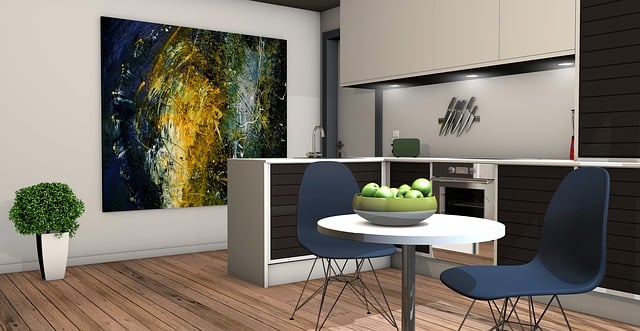Air leaks around doors, windows, and gaps in energy-efficient kitchen appliances can drastically reduce home energy efficiency, especially in extreme climates. Sealing these leaks not only creates a comfortable indoor environment but also ensures that energy efforts translate into reduced usage and costs. Weatherproofing strategies, such as sealing gaps and using high-quality materials, optimize utility bills and protect appliances from moisture and varying weather conditions, leading to lower energy consumption and extended appliance lifespans.
In the pursuit of energy efficiency, ensuring proper sealing and weatherproofing in your kitchen appliances is paramount. Air leaks can significantly impact energy consumption, leading to higher utility bills and reduced appliance durability. This article guides you through understanding these leaks, identifying common problem areas, and implementing effective sealing techniques. By embracing weatherproofing strategies, you’ll not only enhance energy savings but also prolong the lifespan of your energy-saving kitchen appliances.
Understanding Air Leaks and Their Impact on Energy Efficiency
Air leaks, often overlooked, can significantly impact the energy efficiency of your home, especially in areas with extreme weather conditions. These tiny gaps and cracks around doors, windows, and other openings may seem insignificant, but they allow heated or cooled air to escape, leading to higher energy consumption. In an era where energy-saving kitchen appliances are becoming the norm, addressing these leaks is a crucial step towards reducing utility bills and minimizing environmental impact.
The consequences of air leaks are far-reaching. During winter, warm air escapes, making your heating system work overtime. Conversely, in summer, cool air from air conditioning systems can leak out, rendering them less efficient. By sealing these gaps, you create a more comfortable indoor environment while ensuring that your energy efforts translate directly into reduced energy usage and costs.
Identifying Common Areas for Sealing in Kitchen Appliances
Identifying common areas for sealing in kitchen appliances is crucial for enhancing energy efficiency and preventing air leaks. Energy-saving kitchen appliances often feature various joints, gaps, and openings that can allow air to escape, undermining their thermal insulation properties. The first step in proper sealing involves examining these areas meticulously, focusing on places like doors, drawers, and seals. These are particularly vulnerable to leakage, as they are constantly opening and closing, introducing opportunities for temperature-controlled air to dissipate.
Paying attention to the gaskets and O-rings is also vital, as these components play a significant role in maintaining airtightness. Over time, they can deteriorate or become misaligned, compromising the overall sealing efficiency. Regular maintenance, including cleaning and replacement if necessary, ensures that these seals continue to function optimally. By addressing these common areas effectively, users of energy-saving kitchen appliances can maximize their performance, reduce energy consumption, and contribute to a more sustainable household.
The Role of Weatherproofing in Preventing Energy Loss
Weatherproofing plays a pivotal role in preventing energy loss from homes, especially in regions with extreme climates. Proper sealing and weatherproofing techniques are crucial for maintaining optimal indoor temperatures and reducing utility bills, particularly when it comes to energy-saving kitchen appliances. By creating an airtight barrier against outdoor elements, these measures minimize heat transfer, ensuring that cool air remains inside during summers and warmth persists during winters.
This is particularly beneficial for energy-efficient appliances commonly found in modern kitchens. Sealing gaps around doors, windows, and vents prevents cold or hot air from escaping, allowing the appliance to maintain its set temperature efficiently. Consequently, weatherproofing enhances the overall performance of these appliances, contributing to a more comfortable indoor environment and further savings on energy costs.
Effective Techniques for Sealing Gaps and Cracks
Sealing gaps and cracks is a critical step in ensuring your home, especially energy-saving kitchen appliances, remains efficient and protected from the elements. Start by identifying even the smallest openings around doors, windows, and other structural points. Use weatherstripping, a simple yet effective technique, to seal these gaps. This thin, flexible material can be applied to the edges of doors and windows, creating a tight seal that prevents air leaks. For cracks in walls or ceilings, consider applying a high-quality caulk. Caulk forms a strong bond, filling and sealing these spaces, thus enhancing insulation and energy efficiency.
Additionally, pay close attention to places where different materials meet, such as corners or joints. These areas are common problem spots for air infiltration. Applying the right sealant can significantly reduce drafts and improve overall home performance. Remember, proper sealing is not just about comfort; it also contributes to cost savings by keeping energy-efficient appliances working optimally.
Long-Term Benefits: Improved Energy Savings and Appliance Durability
Proper sealing and weatherproofing are essential not just for protecting your home from the elements, but also for long-term benefits that extend beyond aesthetics. By ensuring a tight seal around doors and windows, and using high-quality weatherproofing materials, you can significantly improve energy efficiency in your space. This is particularly beneficial when it comes to energy-saving kitchen appliances—a key area where air leaks can lead to significant power wastage.
Sealing gaps and cracks not only keeps the cold or hot air inside during extreme temperatures but also prevents outdoor elements from entering, thus maintaining optimal conditions for your appliances. Well-insulated spaces mean less work for heating and cooling systems, which translates to reduced energy consumption and lower utility bills. Additionally, keeping out moisture and varying weather conditions can extend the lifespan of your kitchen appliances, ensuring they function at peak performance for years to come.
By implementing proper sealing and weatherproofing techniques, you can significantly enhance the energy efficiency of your kitchen appliances. Understanding where air leaks occur and using effective sealing methods not only reduces energy loss but also extends the lifespan of your appliances. Investing in these practices is a smart step towards more sustainable living and substantial long-term energy savings. Make the switch to energy-saving kitchen appliances today and reap the benefits of a well-sealed, efficient home.
